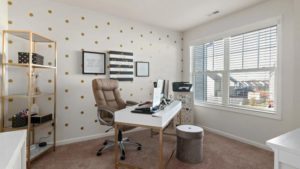Table of Contents
In today’s fast-paced world, the trend of remote work is increasing exponentially. From freelancers to corporate employees, a home office is becoming more of a necessity than a luxury. The efficiency of this workspace, however, can be a make-or-break factor in your productivity. If you find yourself constantly distracted, unable to concentrate, or feeling uncomfortable in your home office, it’s time to reevaluate. This article will help guide you through improving the efficiency of your home office, turning it into a space where you can produce your best work.
How You Can Improve The Efficiency Of Your Home Office?
Layout and Furniture Placement
Before we delve into the intricacies of digital organization, let’s start with the physical space – your home office’s layout and furniture placement. A well-thought-out office layout can drastically improve your efficiency, simply by minimizing disruptions and optimizing space.

The first step is to assess the room’s flow. Make sure that all essential items like your desk, chair, and storage units are within easy reach. You don’t want to be stretching or constantly getting up to grab a document or a file. The rule of thumb here is to design the room in a way that allows seamless movement. One of the most popular approaches is the ‘activity zone’ layout. Here, you group furniture and items based on their functions. For example, you might have a main desk area for computer work, a quiet reading corner, and a space for non-digital tasks like brainstorming on a whiteboard. This type of arrangement can help your brain associate certain areas with specific tasks, enhancing your focus and productivity.
Ergonomics Matter
Working from home doesn’t mean compromising on comfort. In fact, having an ergonomically sound workspace is paramount to not only your work efficiency but also your health. It’s easy to underestimate the impact of physical discomfort until it’s too late, and you’re dealing with backaches or wrist strains.
Select a chair that supports your lower back and encourages good posture. When seated, your feet should be flat on the floor, and your elbows should form a 90-degree angle when typing. The top of your computer screen should be at or slightly below eye level.
While the specifics can vary depending on personal preferences and individual health factors, the goal is to create a workspace that minimizes strain on your body, particularly during those long work sessions. By investing time in creating an ergonomically friendly workspace, you’ll notice a significant increase in your productivity and a decrease in work-related aches and pains.
Importance Of Lighting
Lighting plays a crucial role in your efficiency and wellbeing. Poorly lit areas can cause eyestrain, headaches, fatigue, and overall discomfort. Ideally, your workspace should have a blend of natural and artificial light sources.
The advantage of natural light cannot be overstated. Try to position your workspace near a window, but take care to position your computer screen to avoid glare.

Artificial lighting is also key, especially for those late nights or gloomy days. A dedicated desk lamp can provide targeted light for your workspace. Opt for bulbs that mimic daylight for the best effect, reducing the harshness often associated with artificial light. Furthermore, consider adding ambient lighting for those times when you’re brainstorming or reading, and you don’t need the full force of task lighting.
The Power of Colour
The colours in your home office can also influence how you feel and work. Different hues evoke various psychological responses. For example, blue is known to stimulate the mind, promoting concentration and productivity. Green is easy on the eyes and can reduce anxiety, making it a good choice for a space where you will spend significant amounts of time. Yellow, a colour often associated with creativity, might be suitable if your work involves a lot of brainstorming and idea generation.
Remember, this doesn’t mean you need to repaint your entire office. Adding elements of these colours through accessories, artwork, or even a feature wall can be enough to create the desired effects.
Controlling Noise Levels
While some people work well with background noise, others require complete silence to focus. Regardless of which category you fall into, controlling noise levels in your home office can drastically improve your efficiency.
If you find noise distracting, consider investing in a pair of noise-cancelling headphones. If you prefer some level of ambient noise, think about having a source of soft music or nature sounds. These can help mask more disruptive noises from the rest of the house or from outside.
Essential Software for Productivity
In the digital era, having the right software at your disposal is crucial for productivity. These tools can streamline your workflow, assist with task management, and even help you maintain a healthier b.
Start with a reliable office suite. This typically includes word processing, spreadsheets, and presentation tools. These are fundamental for most professions and are available in various formats, both offline and online, free and paid.

Communication tools should also not be overlooked. Depending on your role, you might need video conferencing software, a professional messaging app, or an email client. These can help you stay connected with clients, colleagues, or supervisors.
Let’s not forget PDF tools. They are particularly useful for viewing, creating, editing, and signing PDF documents. Given the universal format of PDFs, these tools are essential for tasks such as filling out forms, signing contracts, or sharing documents that retain their formatting. You can use the services from PDF Tools to get more out of your PDFs. For example, you could make your document workflows easier, faster, and stress-free.
Stay Organized
Staying organized is not only about keeping your workspace tidy but also about knowing where everything is. Misplacing a document or spending too much time searching for a file can interrupt your workflow and cause unnecessary stress.
Start by having a place for everything. This can be a filing cabinet for your physical papers and a well-structured folder system on your computer for digital ones. For physical items, consider using organizers, trays, and containers to keep your desk clutter-free. Make it a habit to return items to their designated spots after use.
In addition to organizing your work-related items, consider how your personal items can affect your workspace. A water bottle, a few healthy snacks, or even a small plant can enhance your work environment and save you time by reducing the number of times you need to leave your desk.
Digital Decluttering
In today’s digital age, an organized computer can be just as important as an organized physical workspace. Start by keeping your desktop clean. Limit the number of icons and arrange them in a way that makes sense to you. Use folders effectively and group related documents together.

Email management is another key area of digital decluttering. Aim to maintain a zero-inbox policy, where you handle each email only once – either reply, delegate, schedule a response, or delete.
Don’t forget to regularly clean up your computer. This includes deleting old files, uninstalling unused software, and emptying your trash.
Implementing Breaks
The idea of efficiency often brings to mind constant work, but breaks are an essential part of maintaining productivity. Regular breaks can help prevent burnout for remote workers and increase overall output.
Incorporate short breaks into your work schedule, even if it’s just stepping away from your desk for a few minutes to stretch or get a drink.
Author Profile

Latest entries
 Home & LivingJuly 12, 2025Shared Planning for a Stronger Future
Home & LivingJuly 12, 2025Shared Planning for a Stronger Future BusinessJuly 4, 2025How To Build an Integrated Development Plan That Works?
BusinessJuly 4, 2025How To Build an Integrated Development Plan That Works? BusinessJuly 1, 2025Investing in Commercial Property: Key Considerations for Business Owners
BusinessJuly 1, 2025Investing in Commercial Property: Key Considerations for Business Owners Social MediaJuly 1, 2025TikTok AI Dance Revolution: Top Trends, Earnings & How to Go Viral
Social MediaJuly 1, 2025TikTok AI Dance Revolution: Top Trends, Earnings & How to Go Viral




